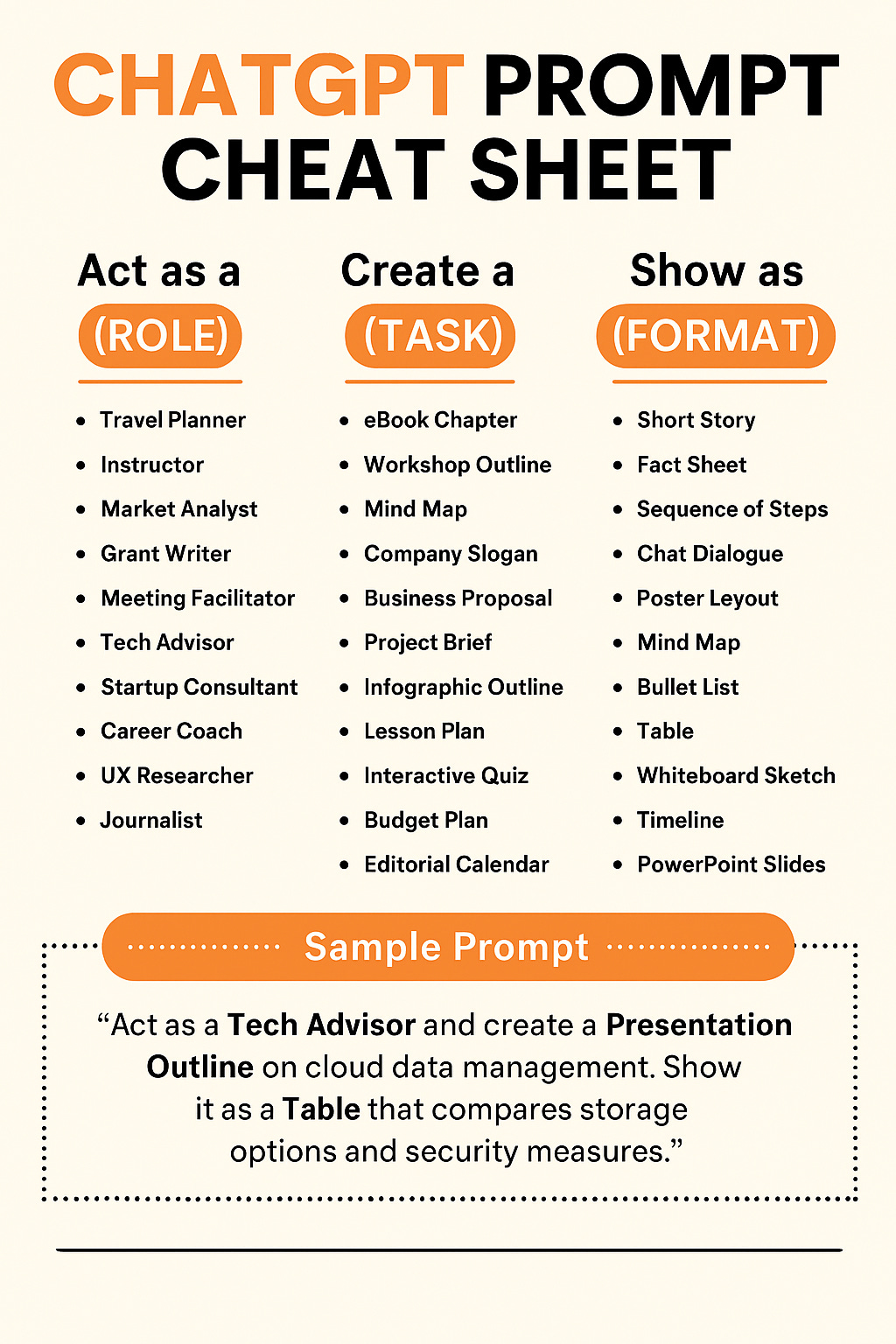The 5 Ingredients of an Effective AI Prompt (And How to Make the Most of Them)
How to write prompts that get real results using ChatGPT, Copilot, or Gemini
🎓 New? Start with our Free Introduction to Generative AI Course
A beginner-friendly walkthrough with 15 plug-and-play prompts, real use cases, and zero jargon. Start now: sgtechsimp.com/challenge-page/beginnergenerativeaicourse
You open ChatGPT, type something like “write a blog post,” and wait.
The results? Generic. A little bland. Not quite what you had in mind.
If that sounds familiar, you’re not alone.
The good news is, AI doesn’t need to be smarter. You just need to be clearer.
Think of prompting like giving directions to a really fast, super talented intern. The more specific you are, the better the outcome. And the best prompts usually follow the same five-part recipe.
This guide will walk you through the 5 essential ingredients of an effective prompt plus exactly how to make the most of them.
So let’s dive in.
1. Act as a Role: Give the AI a Clear Identity
Your first move? Tell ChatGPT who it is.
Giving it a role sets the tone for the conversation. You wouldn’t speak to a lawyer the same way you would speak to a marketing intern. The same rule applies here.
Example roles to try:
Social media strategist
Nutritionist
Scriptwriter
UX researcher
Travel planner
Startup consultant
When you assign a role, you help ChatGPT make smarter, more relevant choices from language to structure to tone.
Try this: "Act as a newsletter copywriter and write an intro for a weekly tech digest aimed at non-technical readers."
You’ve just unlocked more useful and natural output.
2. Create a Task: Be Clear About What You Want
Next, tell the AI what to do.
Vague prompts like "help me with my content" are too open. The AI doesn’t know if you want ideas, outlines, drafts, or editing.
The task is the action write, generate, explain, outline, brainstorm. The more clearly you describe it, the faster you get something that works.
Examples of clear task prompts:
"Create a budget plan for a team offsite."
"Generate a list of 10 social media post ideas for a wellness brand."
"Summarize this research article in three bullet points."
Power tip: If you don’t know the task name, describe the outcome. "Help me create something that will introduce our new product to clients in a short, visual format."
3. Show as a Format: Structure Matters
Great prompts also tell ChatGPT how to present the answer.
Do you want a bullet list? A table? A step-by-step plan? Or a short paragraph you can copy and paste into an email?
The right format makes the result easier to use and way faster to edit.
Useful formats to try:
Table
Timeline
Fact sheet
Email draft
Slide outline
Gantt chart
List of pros and cons
Example: "Act as a project manager. Create a launch plan as a Gantt chart for our mobile app."
With that one sentence, you’ve given the AI a role, a task, and a format.
4. Add Context: Tell the AI What It Needs to Know
Context gives your prompt depth.
It’s one thing to say, "Write an event invitation."
It’s way better to say, "Write a friendly email invitation for a tech webinar aimed at marketing professionals, happening next Thursday."
The difference? The first is generic. The second gives tone, audience, and timing.
What counts as helpful context?
Target audience (who it’s for)
Goals or outcomes
What already exists
Examples you liked
Tone or style you want
Try this: "Act as a PR manager. Write a press release about our AI feature launch, aimed at startup founders. Keep it clear, confident, and under 200 words."
5. Set Guidelines: Steer the Output
Last but not least give boundaries.
Tell ChatGPT what to avoid. What to emphasize. What to skip.
Just like a human writer, AI does better when it knows the limits.
Guidelines might include:
Avoid technical language
Keep under 100 words
Include three examples
Don’t sound overly formal
Use inclusive language
Example prompt with guidelines: "Act as a resume editor. Improve this bio for LinkedIn. Keep the tone friendly and confident. Avoid buzzwords like ‘rockstar’ or ‘guru.’ Limit to two short paragraphs."
You’re helping the AI get closer to what you really want the first time.
Bonus: Sample Prompt That Uses All 5 Ingredients
“Act as a Social Media Strategist and create a Newsletter Draft for our tech startup’s product launch. Show it as a Fact Sheet that highlights key features, target audience, and campaign hashtags. Keep the tone clear and upbeat. Avoid technical terms."
Boom. That’s a complete, clear, and highly effective prompt.
You’ve told the AI who to be, what to make, how to format it, what to include, and what to avoid.
Final Thought: Save It, Share It, Use It
Great prompts save time. They sharpen your thinking. And they help you get better results without starting from scratch.
Use these five ingredients anytime you’re working with ChatGPT, Copilot, Gemini, or any other large language model. The structure works no matter the platform.
And if you want a printable cheat sheet of everything in this guide, download it now or share it with your team.
You don’t need to write perfectly. You just need to prompt better.
Start here.
More coming soon at Tech Simplified subscribe to stay ahead of the curve.
✅ Save this post for your next creative block.
💬 Share it with someone who needs AI to be simpler.
🎯 Then try a prompt today and see how much time it saves you.
🧠 Want full hands-on training and templates? That’s Growth Pass at sgtechsimp.com/training.
✍️ Want stories, tips, and insights? That’s the Substack blog at techsimplifiedai.substack.com.





